
Oakland is a city in the San Francisco Bay Area in the U.S. state of California. It is the seat and most populous city in Alameda County, with a population of 440,646 in 2020. A major West Coast port, Oakland is the most populous city in the East Bay region, the third most populous city in the Bay Area, and the eighth most populous city in California. It serves as the Bay Area's trade center: the Port of Oakland is the busiest port in Northern California, and the fifth- or sixth-busiest in the United States. A charter city, Oakland was incorporated on May 4, 1852, in the wake of the state's increasing population due to the California gold rush.

Burning Man is a week-long large-scale desert event focused on "community, art, self-expression, and self-reliance" held annually in the western United States. The event's name comes from its culminating ceremony: the symbolic burning of a large wooden effigy, referred to as the Man, that occurs on the penultimate night, the Saturday evening before Labor Day. Since 1991, the event has been at Black Rock City in northwestern Nevada, a temporary city erected in the Black Rock Desert about 100 miles (160 km) north-northeast of Reno. According to Burning Man co-founder Larry Harvey in 2004, the event is guided by ten stated principles: radical inclusion, gifting, decommodification, radical self-reliance, radical self-expression, communal effort, civic responsibility, leaving no trace, participation, and immediacy.
The Cacophony Society is a US-based organization that consists of individuals "united in the pursuit of experiences beyond the pale of mainstream society." In 1986, the organization was created by the surviving members of the defunct Suicide Club of San Francisco.

Gerlach, Nevada is a census-designated place (CDP) in Washoe County, Nevada, United States. The population was 130 at the 2020 census. It is part of the Reno–Sparks Metropolitan Statistical Area. Prior to 2010, Gerlach was part of the Gerlach–Empire census-designated place. The town of Empire is now a separate CDP. The next nearest town, Nixon, is 60 miles (100 km) to the south on a reservation owned by the Pyramid Lake Paiute Tribe. The Fly Geyser is located near Gerlach.

The Oakland Tribune was a daily newspaper published in Oakland, California, and a predecessor of the East Bay Times. It was published by the Bay Area News Group (BANG), a subsidiary of MediaNews Group. Founded in 1874, the Tribune rose to become an influential daily newspaper. With the decline of print media, in 2016, the paper announced that the Tribune would fold into a new newspaper entitled, the East Bay Times along with its owners other newspapers in the East Bay starting April 5, 2016. The former nameplates of the consolidated newspapers will continue to be published every Friday as weekly community supplements.
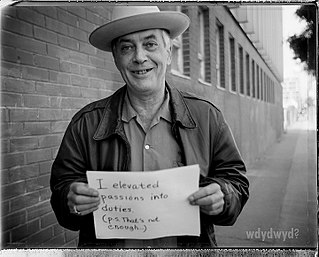
Larry Harvey was an American artist, philanthropist and activist. He was the main co-founder of the Burning Man event, along with his friend Jerry James.
The Suicide Club was a secret society in San Francisco, which lasted from 1977–82. It is credited as the first modern extreme urban exploration society, and also known for anarchic group pranks. Despite its name, the club was not actually about suicide. Rather the club focused on people facing their fears and engaging in daring experiences.

The East Bay is the eastern region of the San Francisco Bay Area and includes cities along the eastern shores of the San Francisco Bay and San Pablo Bay. The region has grown to include inland communities in Alameda and Contra Costa counties. With a population of roughly 2.5 million in 2010, it is the most populous subregion in the Bay Area.
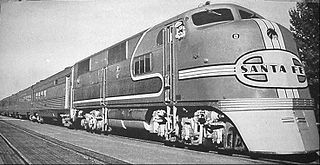
The Golden Gate was one of the named passenger trains of the Atchison, Topeka and Santa Fe Railway. It ran on the railroad's Valley Division between Oakland and Bakersfield, California; its bus connections provided service between San Francisco and Los Angeles via California's San Joaquin Valley.

The Burning Man Project is the organization that annually plans, manages, and builds Burning Man on the dry lake of the Black Rock Desert in northwestern Nevada. The company coordinates the year-round, behind-the-scenes work needed to build and remove a temporary city of 80,000 people.
Barbara Traub is an American photographer, who was born and raised in Baltimore, Maryland. Several years after graduating from Johns Hopkins University, she went on an exchange program to an art school in Florence, Italy, for a semester with the intention of doing painting and drawing but at the last minute was handed a camera, thus establishing her future direction.

Oscar Grant III was a 22-year-old Black man who was killed in the early morning hours of New Year's Day 2009 by BART Police Officer Johannes Mehserle in Oakland, California. Responding to reports of a fight on a crowded Bay Area Rapid Transit train returning from San Francisco, BART Police officers detained Grant and several other passengers on the platform at the Fruitvale BART Station. BART officer Anthony Pirone kneed Grant in the head and forced Grant to lie face down on the platform. Mehserle drew his pistol and shot Grant. Grant was rushed to Highland Hospital in Oakland and pronounced dead later that day. The events were captured on bystanders’ mobile phones. Owners disseminated their footage to media outlets and to various websites where it went viral. Both protests and riots took place in the following days.
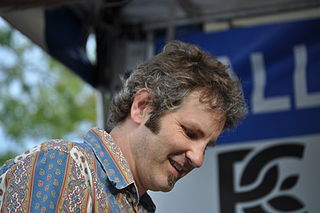
Mark Nichols is an American playwright, composer, and lyricist, best known for his musicals Little Boy Goes to Hell (1988), Joe Bean (2003), and How to Survive the Apocalypse (2009). He is also known in the northwestern United States for his work with Fred Jamison for whom he arranged 20 Northwest Coast Native songs for orchestra, girl choir, and rock band, performed by the Seattle Symphony in 1996.

Doggie Diner was a small fast food restaurant chain serving hot dogs and hamburgers in San Francisco and Oakland, California that operated from 1948 to 1986, owned by Al Ross.
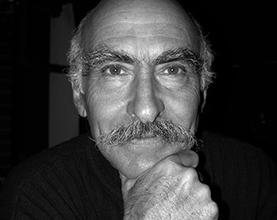
Pepe Ozan (1939–2013) was an Argentine sculptor, artistic director, and filmmaker. He lived in the San Francisco Bay Area for many years, and is known for his lasting influence at Burning Man, an annual experimental arts festival in Nevada, United States.
Mark Grieve is an American contemporary artist. He practices in a variety of media including found objects and large metal sculpture as well as site-specific installations, performance, and public art.
The following is a timeline of the history of the city of San Francisco, California, United States.

Trego Hot Springs is located in the Black Rock Desert at the location of Trego, Nevada, a former station on the Western Pacific Railroad. The name "Trego" dates from the 1910s, just after the railroad was built. Previously, the springs had names like Hot Springs, Kyles Hot Springs (1864), Butte Spring, and Butte Hot Spring.
Desert Siteworks was an event held on the Black Rock Desert for three years (1992-1994). Participants built art and participated in self-directed performances.
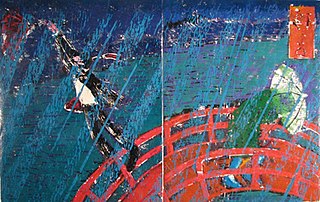
Robert Brokl is an American visual artist and activist based in the Bay Area, known for expressive woodblock printmaking and painting that has focused on the figure, landscape and travel for subject matter. His visual language combines the influences of German Expressionism, Japanese woodblock printing and the Bay Area Figurative Movement with a loosely autobiographical, Romantic interest in representing authentic personal experience, inner states and nature. Critics and curators characterize his style by its graphic line, expressive gestural brushwork, tactile surfaces and sensitivity to color, mood and light.
















